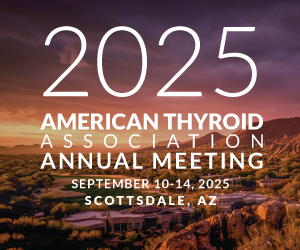|
2006-2007 President Secretary Treasurer President-Elect Secretary-Elect Treasurer-Elect Directors Bryan R. Haugen, M.D. (2007) Sandra M. McLachlan, Ph.D. (2007) Gilbert H. Daniels, M.D. (2008) Steven I. Sherman, M.D. (2008) Matthew D. Ringel, M.D. (2009) Mary H. Samuels, M.D. (2009) Antonio C. Bianco, M.D., Ph.D. (2010) Alan L. Farwell, M.D. (2010) Michael T. McDermott, M.D. (2010) Executive Director Headquarters Office
|
January 25, 2007
President George W. Bush Dear President Bush: We are writing on behalf of the American Thyroid Association (ATA) to request that you rectify a very significant deficit in a particular aspect of antiterrorism preparation: namely, the lack of availability of potassium iodide (KI) for protection of young people against developing thyroid cancer in the event of a release of radioactive iodine. The ATA is a professional society of over 900 endocrinologists, surgeons and nuclear medicine physicians and researchers specializing in diseases of the thyroid gland. The ATA promotes excellence and innovation in clinical care, research, education, and public advocacy. Section 127 of the 2002 Bioterrorism and Response Act directed you to establish a program that would increase the availability of KI to State and local governments for persons within 20 miles of a nuclear power plant. In response, a 2004 study by the National Academy of Sciences (NAS) recommended that “KI should be made available to everyone at risk of significant health consequences from accumulation of radioiodine in the thyroid in the event of a radiological accident”. Draft guidelines were then prepared by the DHHS, published in the Federal Register in August 2005, and revised after considering comments from the public. We understand that these revised guidelines have long been pending in the White House Office of Management and Budget as a result of objections raised by the Nuclear Regulatory Commission. Dr. William Kane from the Nuclear Regulatory Commission writes in his November 1, 2005 letter to Dr. Claypool of DHSS that removal and isolation of contaminated products is equal to or superior to KI protection of the thyroid gland after radioactive iodine release. Although this statement is supported by reference to the NAS report, our Public Health Committee, including several members of the NAS panel, believe that these statements are taken out of context. KI ingestion is the only tested and proven approach to protect against thyroid cancer. The nuclear power station accident at Chernobyl in 1986 has made it perfectly clear that an accident or terrorist act at a power station in the USA could result in literally thousands of cases of thyroid cancer in children exposed to released radioiodines. The safety and effectiveness of KI in preventing these cancers is well established, especially the successful Polish experience with KI distribution after the Chernobyl accident. KI is not a panacea for all radiation effects, but it is an essential addition to other protective measures, namely sheltering, evacuation, and restriction of contaminated foods, to protect the thyroid against inhaled or ingested radioiodines. The NAS report also states that it must be remembered that the plume phase and ingestion phase protection zones are established to provide a planning basis, and that a specific incident might call for protective actions to be implemented beyond the planning zone. Increasing the number and distribution of KI stockpiles is key to improved protection because KI must be given very quickly to be effective. Individually sealed KI tablets protected from light are long lasting. Although we have fortunately not yet had an accident that has required KI, it is irresponsible that this simple and inexpensive remedy has yet to be put in place to protect our young people. We urge you to put an end to this unnecessary delay as soon as possible and institute the DHSS guidelines. We look forward to your response, and are prepared to offer our expertise in the evaluation and implementation of this policy. Respectfully submitted,
|




